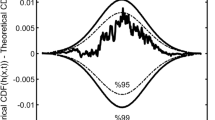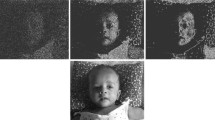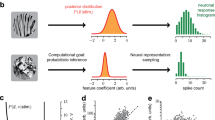Summary
Synthesis of the well-known coincidence and fluctuation concepts for description of visual threshold in dependence of geometry and duration of test stimulus and of luminance and of color of a masking background was based on an arithmetic adaptation mechanism in the data processing action of the retina upon the incident quanta (Bouman, 1964; Bouman and Ampt, 1966). This mechanism is essentially a scaler with a scale factor depending on the present and past values of the input intensity and is for a constant input proportional and nearly equal to the square root of the average quanta input per unit time upon the scaler's retinal area. An increase of input makes the scale factor increase with a fixed number for every other pulse of the excess-output. This makes the successive K-values during light adaptation follow an arithmetic series. For dark-adaptation another adequate procedure is suggested. The neurophysiological relevance of the model is demonstrated by successful description of a number of experimental studies on spike-behavior notably by Hartline, Mueller, Ratliff and Kuffler, Fitzhugh and Barlow. As the model stems from psychophysical studies, relevance for visual threshold behavior is implicit in the paper. The De Vries-Rose law and Weber-Fechner law are proven to have unique positions in systems with one stage stochastical scaling mechanisms.
Similar content being viewed by others
References
Alaoglu, L., and N. M. Smith jr.: Statistical theory of a scaling circuit. Phys. Rev. 53, 832 (1938).
Bouman, M. A.: Peripheral contrast thresholds of the human eye. J. opt. Soc. Amer. 40, 832 (1950).
— Peripheral contrast threshold for various and different wavelengths for adapting field and test-stimulus. J. opt. Soc. Amer. 42, 820–832 (1952a).
— Mechanisms in pheripheral dark adaptation. J. opt. Soc. Amer. 42, 941–950 (1952b).
— History and present status of quantum theory in vision. In: Sensory communications, ed. W.A. Rosenblith. London: M. I. T. Press/John Wiley & Sons Inc. 1961 a.
— Sensory phenomena. Rendiconti S. I. P. XVI Corso, Physicomathematical aspects of biology. New York: Academic Press 142, 1961 b.
— Efficiency and economy in impulse transmission in the visual system. Acta psychol. (Amst.) 23, 239 (1964).
Bouman, M. A., and C. G. F. Ampt: Fluctuation theory in vision and its mechanistic model. In: Performance of the eye at low luminances, eds. M. A. Bouman, J. J. Vos. Excerpta Medica International Congress Series no. 125, Amsterdam (1966).
Bouman, M. A., and G. van den Brink: On the integrate capacity in time and space of the human peripheral retina. J. opt. Soc. Amer. 42, 617 (1950).
Bouman, M. A., and J. ten Doesschate: Nervous and photochemical components in visual adaption. Ophtalmologica (Basel) 126, 222 (1953).
Bouman, M. A., and J. ten Doesschate The mechanism of dark adaption. Vision Res. 1, 386 (1962).
Bouman, M. A., and H. A. van der Velden: The two-quanta explanation of the dependence of the threshold values and visual acuity on the visual angle and the time of observation. J. opt. Soc. Amer. 37, 908 (1947).
Bouman, M. A., J. J. Vos, and P. L. Walraven: Fluctuation theory of luminance and chromaticity discrimination. J. opt. Soc. Amer. 53, 121 (1963).
Brink, G. van den, and M. A. Bouman: Variation of integrative actions of the retina system: an adaptational phenomenon. J. opt. Soc. Amer. 44, 616 (1954).
Brink, G. van den, and M. A. Bouman Quantum coincidence requirements during dark-adaptation. Vision Res. 3, 479 (1963).
Cox, D. R., and W. L. Smith On the superposition of renewal processes. Biometrika 41, 91 (1954).
Grind, W. A. van de, T. van Schalm, and M. A. Bouman: A coincidence model of the processing of quantum signals by the human retina. Kybernetik 4, 141 (1968).
Hartline, H. K.: Intensity and duration in the excitation of single photoreceptor units. J. cell. comp. Physiol. 5, 229 (1934).
Hartline, H. K., and C. H. Graham: Nerve impulses from single receptors in the eye. J. cell. comp. Physiol. 1, 277 (1932).
Hecht, S.: The quantum relations of vision. J. opt. Soc. Amer. 32, 42 (1942).
Jost, R.: Bemerkungen zur mathematischen Theorie der Zähler. Helv. Phys. Acta 20, 173 (1947).
Kuffler, S. W., R. Fitz Hugh, and H. B. Barlow: Main, tained activity in the cat's retina in light and darkness. J. gen. Physiol. 40, 683 (1957).
Mueller, C. G.: A quantitative theory of visual excitation for the single photoreceptor. Proc. nat. Acad. Sci. (Wash.) 40, 853 (1954).
Ramakrishnan, A., and P. M. Mathews: A stochastic problem relating to counters. Phil. Mag. 44, 1122 (1953).
Ricciardi, L. M., and F. Esposito: On some distribution functions for non-linear switching elements with finite dead time. Kybernetik 3, 148 (1966).
Rushton, W. A. H.: Visual adaptation. The Ferrier Lecture 1962. Proc. roy. Soc. B 162, 20 (1965).
Velden, H. A. van der: Over het aantal lichtquanta, dat nodig is voor een lichtprikkel bij het menselijk oog. Physica 11, 179 (1944).
Vries, Hl. de: The quantum character of light and its bearing upo'n threshold of vision, the differential sensitivity and visual acuity of the eye. Physica 10, 553 (1943).
Author information
Authors and Affiliations
Rights and permissions
About this article
Cite this article
van de Grind, W.A., Bouman, M.A. A model of a retinal sampling-unit based on fluctuation theory. Kybernetik 4, 136–141 (1968). https://doi.org/10.1007/BF00288546
Received:
Issue Date:
DOI: https://doi.org/10.1007/BF00288546




